Palm trees immediately remind us of a tropical oasis. We see these trees and imagine we’re sitting in the sand, sipping a Mai Tai, and listening to the waves lap onto the beach. You’re feeling more relaxed already, aren’t you? It’s no wonder that homeowners are increasingly seeking to add palm trees to their landscapes. Why not bring a bit of the tropics to your home, right? If your home happens to be in Texas, we have some good news for you. There are palm trees that can thrive on your property. But deciding which trees to plant depends heavily on where you live in the Lone Star State.
Choosing a Palm Tree
Palm trees are part of the plant family Arecaceae, a family of perennial flowering plants in the monocot order Arecales. There are over 2,600 species of palms.
Choosing the right trees for your landscape can be daunting with that many palm species. Although, in reality, the choices are a bit narrower than that because not all of the 2,600 palm species are commercially available. Even so, it can still be confusing when trying to choose the right palm tree for your landscape. Knowing your USDA hardiness zone will make all the difference.
A lot of landscapers love palm trees, not only because of their tropical vibe, but also because of their high wind tolerance. Many of these tropical trees are built to withstand hurricane-force winds. But, while many palm tree varieties are wind-resistant, far fewer are cold-resistant. Remember, these are tropical trees. Palm trees that thrive in south Texas may not stand a chance in the northern reaches of the state.
Texas is the largest of the 48 contiguous states. With such a vast land area, the state naturally features a wide range of hardiness zones. Growers in Texas can live in regions from Zone 6b in the north to Zone 10a in the extreme southern tip of the state. For some perspective on just how wide this range really is, Zone 6b can be found in southern Ohio, while Zone 10a is the hardiness zone for much of central Florida. Did we mention it is a wide range?
However, there are palm trees that can thrive in all of these hardiness zones. While this certainly is not an exhaustive list, let’s explore some of the best palms for each region in Texas.

These palm trees growing in Corpus Christi, Texas, can withstand hurricane-force winds.
©iStock.com/carrollmt
Saw Palmetto (Serenoa repens)
Growers in the extreme northern region of the Texas Panhandle, this palm species is for you! The saw palmetto is one of the most cold-hardy palms on the market.
It is a low-growing fan palm with stiff palmate leaves and a spiny stem. The leaves are light to medium green with harmless serrated stems. The tree typically grows along the ground and seldom has an upright trunk. Some horticulturists don’t even classify it as a tree but rather a shrub-like plant. Whatever you call it, this palm species is drought-resistant and is hardy to Zone 7a, but many growers have seen outstanding results in Zone 6b. These growers report this palm has withstood temperatures as low as -5°F.
You’ve likely heard of saw palmetto even if you’ve never grown one. It is a popular pharmaceutical and dietary supplement. But it is also a wonderful, cold-hardy ornamental plant. North Texas gardeners, rejoice!
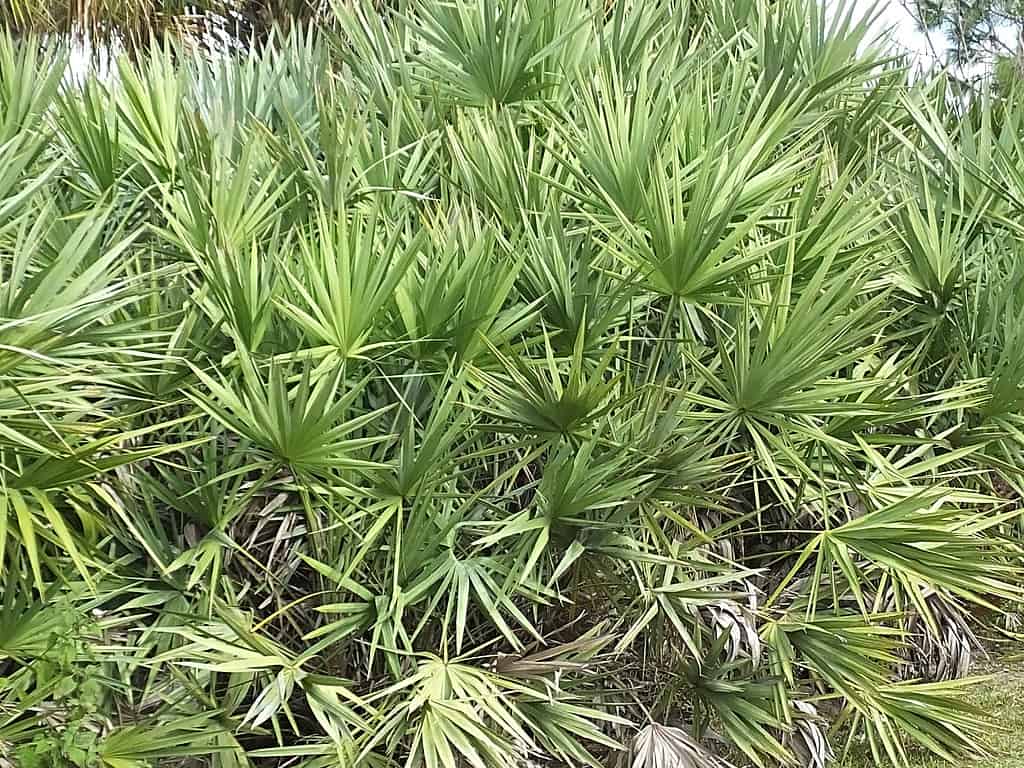
Saw palmetto is an exceptionally cold-hardy palm.
©iStock.com/passion4nature
Dwarf Palmetto (Sabal minor)
The dwarf palmetto is one of two palm species native to Texas. The other is the Mexican palmetto, which we will discuss below. If a palm species grows naturally in the wilds of Texas, it’s a good bet that it will also grow well on your property.
The dwarf palmetto is another palm species that can weather an occasional cold snap fairly easily. This tree is hardy to Zone 7. Growers in Amarillo, for example, can expect this palm to thrive in their landscapes.
It can also take the heat, too. The dwarf palmetto can thrive up to Zone 10, meaning growers in Brownsville can also enjoy this palm. It is salt-tolerant, so it is great for coastal regions. The dwarf palmetto can handle drought conditions but can also grow in poorly drained soil. To put it simply, this is one tough little palm! Other than the very northern sections of the Panhandle, virtually every Texas grower can enjoy this palm species in their landscape.
This palm may feature a short trunk but is often trunkless. It usually grows more like a shrub, but it can occasionally grow to the height of a small tree. On average, plan for maximum vertical growth of five to ten feet.
The petioles produce large, fan-shaped leaves that can grow as wide as three feet in diameter. The shiny leaves vary from bluish-green to dark green. White-cream-colored flowers with a strong fragrance bloom in the spring.
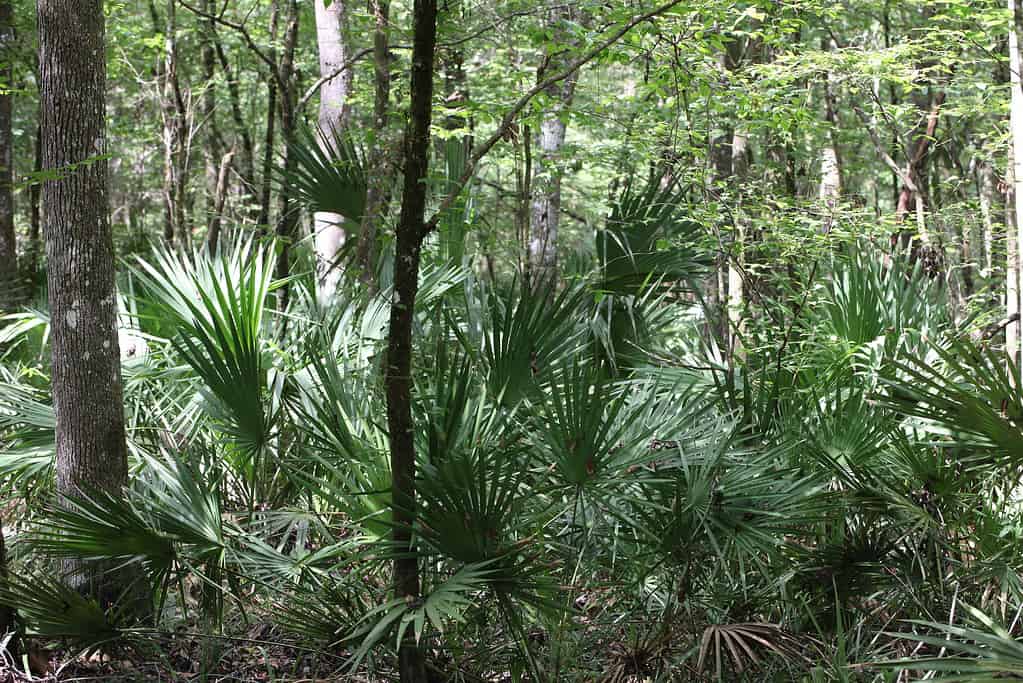
The dwarf palmetto is a native Texas palm that is cold-hardy to Zone 7.
©iStock.com/viktor2013
Cabbage Palm (Sabal palmetto)
Unlike the previous palms, no one debates whether or not the cabbage palm is a tree. With heights of 40 feet or more, it is most definitely a palm tree.
The cabbage palm (also known as the sabal palm, blue palmetto, cabbage tree, and common palmetto) is native to the southeast United States. It is the official state tree of both Florida and South Carolina.
This palm tree is hardy to Zone 8 and can withstand the heat up to Zone 11. Roughly speaking, Texans from Abilene south to the state’s border with Mexico can grow thriving cabbage palms. These palms are salt and drought-tolerant, so they can handle a dry Texas summer and can also thrive in the state’s coastal regions.
Cabbage palms have trunks with a uniform diameter from the base to the peak. The tree has no branches and features fan-shaped fronds at the top, held by stiff, woody stalks.
The common name “cabbage palm” comes from its edible immature leaves, or “hearts,” which have a cabbage-like flavor.
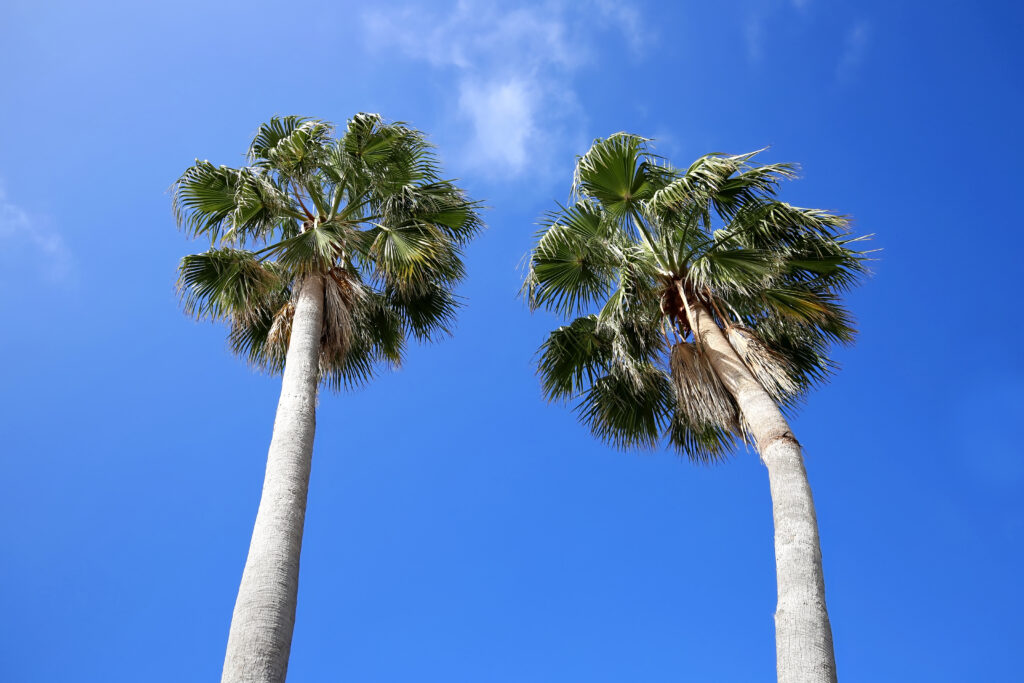
The cabbage palm grows upwards of 40 feet tall.
©Jillian Cain Photography/Shutterstock.com
Mexican Palmetto (Sabal mexicana)
Along with the dwarf palmetto, the Mexican palmetto is Texas’ other native palm tree. The tree’s natural range stretches from Texas through Mexico to Guatemala.
Also known as the Texas palmetto and the Rio Grande palmetto, the Mexican palmetto has the same hardiness as the cabbage palm. It thrives in Zones 8-11. Some sources are reporting success in growing the tree in Zone 7b, but the official recommendations have yet to be adjusted.
The trunk of this robust palm can grow to 32 inches in diameter. The tree can reach heights of 50 feet with a 25-foot spread. The leaves will be a deep emerald green if the tree is more shaded. If it receives full sun, the leaves will turn a lighter green.

The Mexican palmetto is another native Texas palm tree.
©iStock.com/Mario Krpan
Pindo Palm (Butia capitata)
The pindo palm is one of the more slow-growing palm trees on the market today, but patient growers are rewarded with a pretty amazing medium-sized palm tree.

The pindo palm is salt-tolerant and is perfect for coastal regions.
©iStock.com/viktor2013
The tree is native to South American nations such as Brazil, Uruguay, and Argentina. As such, it thrives only in warmer climates. The pindo palm is recommended for Zones 9-11. Growers in much of east Texas can enjoy this tree, as can gardeners throughout the southern part of the state. The tree is salt, heat, and drought tolerant.
The pindo palm grows between 10-20 feet tall with a 10-15 foot spread of bluish-gray/green leaves. The weight of the leaves causes a slightly weeping shape. The trunk is patterned with the shape of old leaves.
This palm is also known as the wine or jelly palm. The tree’s jelly and wine common names come from the fruit this tree produces. Small, citrus-scented flowers appear in the summer. Those flowers are followed by orange-yellow fruit. These fruits are around an inch long and have a flavor reminiscent of pineapple. The fruit can be eaten straight from the tree. It can also be used in jellies and jams, or fermented to make wine.

The fruit of the pindo palm is used in jellies and wines.
©iStock.com/Lubo Ivanko
Queen Palm (Syagrus romanzoffiana)
Like the pindo palm, the queen palm is another South American tree that is recommended for Zones 9-11. Unlike the pindo palm, though, this tree is relatively fast-growing.
Also known as the cocos palm or jeriva palm, the queen palm can grow to towering heights of 60 feet or more with glossy green fronds up to 15 feet long. It produces creamy white flowers in the summer, followed by clusters of orange fruit in late fall or early winter. Unlike the fruit of the pindo palm, no one uses this fruit to make jelly or wine. The queen palm’s fruit is inedible to humans. It is, however, a favorite of birds and some mammals.
Whatever fruit the local wildlife does not consume will fall to the ground and can form sticky mounds of rotting fruit. Growers will want to stay ahead of this, not only because it can become a sticky mess if left unattended but also because the seeds can take root and unwanted seedlings can sprout.
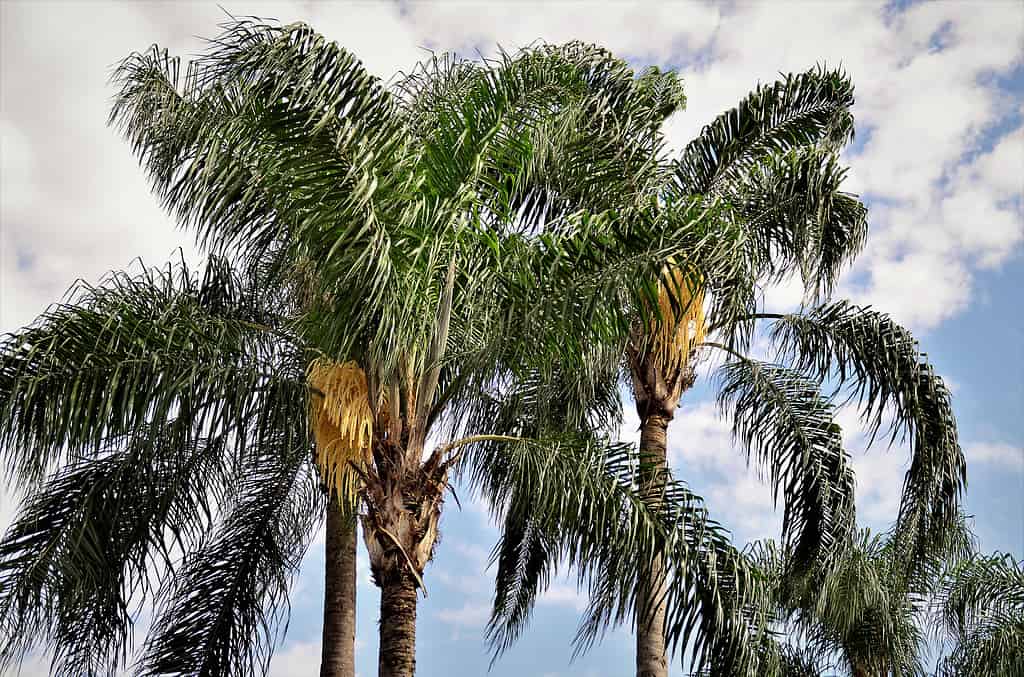
The queen palm reaches heights up to 60 feet tall.
©iStock.com/ancyAyumi
The Basics of Palm Tree Care
Now that you have a few ideas for your landscape let’s talk about the basics of caring for these tropical trees. It is just that: basic. Most varieties of palm trees require little to no maintenance once they are established.
Planting
Water the palm tree well before planting. Dig a hole deep enough to accommodate the root ball’s height, and about twice as wide as the root ball’s width. Place the root ball in the hole and ensure the tree is standing straight. The top of the root ball should rise just above the soil line. Fill in the hole with half native soil and half commercial planting mix. Water the tree generously. Add one to two inches of mulch around the tree and water it daily for the first week.
Establishing
After that first week of daily watering, plan to water the palm twice weekly for the next few months. Most palm trees are drought tolerant once they are established, but generous watering for the first two or three months is recommended.
Depending on your soil quality, adding some fertilizer can be helpful. A slow-release fertilizer in the spring is recommended. If the soil is especially nutrient deficient, another shot of fertilizer in the fall can be beneficial.
In cooler zones (we’re looking at you, Texas Panhandle), wrapping young palm trees with burlap or frost cloth during cold snaps can help protect them. The cold-hardy palms discussed above likely will not need this extra protection once they are fully established. Deep watering and a thick layer of mulch can also help protect the trees in cold temperatures.
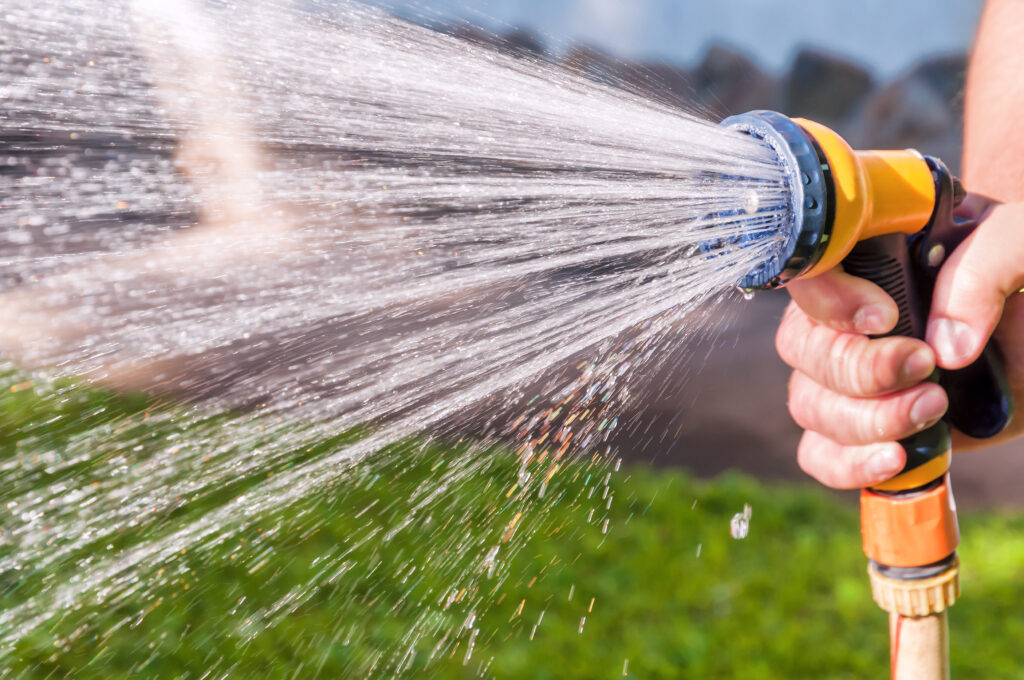
Watering in the first few months after planting can help your palm establish more quickly and promote healthy growth.
©iStock.com/vovashevchuk
Pruning
Most palm trees do not require pruning. You can remove any damaged foliage, though, to encourage new, healthy growth. Cut the damaged foliage with sharp pruning shears on smaller trees or with a pole saw for larger palms.
This is not a requirement, though. It’s purely aesthetic. Palm tree foliage will die back naturally. It is fine to simply allow the process to play out. But for gardeners who want to speed up the new growth, cleaning off damaged or dead foliage can expedite the process.
The photo featured at the top of this post is © lazyllama/Shutterstock.com
Thank you for reading! Have some feedback for us? Contact the AZ Animals editorial team.






